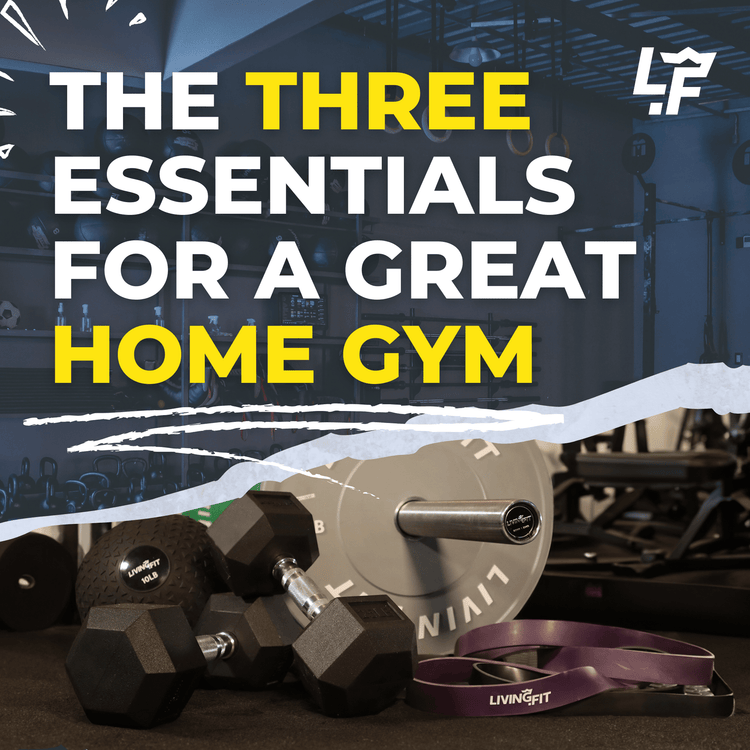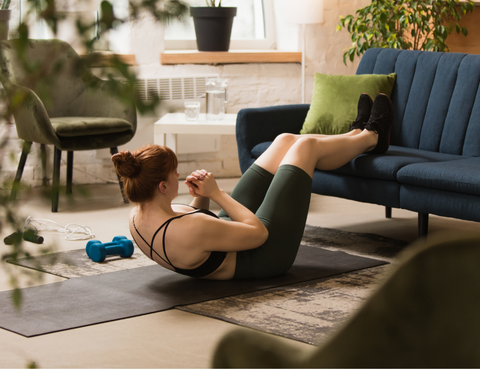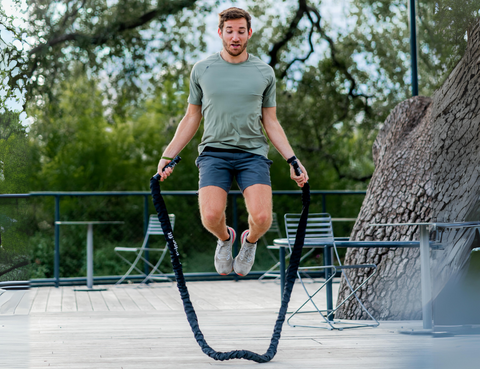Essentials for a Home Gym: Top 3

Ask ten home gym owners what you need to build a great home gym, and you'll get ten different answers. That's because each of those people has unique needs and enjoys various types of training.
This can make it hard for someone trying to build a home gym to figure out what they should and shouldn't get.
So, let's try to make this as simple and easy as possible...
A great home gym consists of 3 essentials for a home gym: space to train, resistance to train with, and an indoor cardio option.
Resistance can range from body weight calisthenics to a complete weight set. Cardio can vary from jumping rope to sandbell swings. Combining cardio and resistance training together results in an ideal home gym.
Too many people get bogged down in the minutiae of which gear is the best or what type of training is most effective.
The simple fact is that the most effective training and gear is the training and gear you will use consistently.
One of the reasons I've grown to appreciate Living.Fit is their non-dogmatic assortment of gear.
It perfectly aligns with this philosophy and gives you, the consumer, many choices to find something you'll love using and be consistent with!
The Importance of Resistance AND Cardio
The fitness community has an ongoing debate about which of these is more important, especially regarding weight loss.
The cardio camp says to spend all your time on the treadmill, while the strength training camp says to stick to the power rack and avoid the treadmill at all costs.
They are both wrong. The correct answer, as with most things, lies in the middle.
Strength training is critically important to ALL fitness pursuits, and cardio is essential for heart health, endurance, and work capacity, among many other things.
With this in mind, building a home gym that accommodates both types of training is critical.
The Essential Three for Home Gym

With that in mind, all great home gyms can be broken down into 3 key components:
What you decide to do for each of those things will be determined first and foremost by your goals. Knowing this will help you build the ideal gym for you.
Space to Train
One of the things that holds people back from training at home is the excuse that they don't have the space. Many people seem to think you need an empty garage or basement if you want to have a home gym.
My first two home gyms took up almost no room in my home. The first consisted of me moving my coffee table to the side and training with a single kettlebell. I did that for over a year! And I had all three needed things in one.
That tiny section of carpet allowed me to do resistance training and cardio with a single kettlebell. Was it a traditional "home gym"? Nope. But it was a home gym I used and benefited from daily!
When I decided to expand my training, I moved to a pullup bar hung in the doorway of my home office. Combined with a set of gymnastics rings, I had everything I needed in the tiny space of a single doorway.
Don't think you have the space for a home gym? Check again. Do you have a living room floor? Do you have a doorway? Then you have the room!
Want to Try Workout Programs You Can Do In Any Corner of Your Home? Get Access to 40+(and counting!) Different Programs + Create Your Own With a Workout Generator! Follow on desktop or mobile!
Resistance Training
Got your space all figured out? Now, it's time to add some form of resistance training.
Here are just a few of the almost endless benefits of resistance training:
- Mobility
- Strength
- Hormone optimization
- Improved sleep
- Reduced depression
- Faster metabolism
- Bone density
- Joint health
- Reduced pain
- Higher work capacity
- Stability
- Increased balance
- Improved cognition and brain function
- Improved libido
- Resistance to infection and illness
I could go on, but I think you get the point. Resistance training has too many benefits to skip.
But what does "resistance training" mean? Too many people hear that phrase and assume they need to squat, deadlift, and bench press.
While I genuinely believe everyone should do those things, I'm also smart enough to know many people won't.
"Resistance training" does NOT have to mean barbells and weight plates. It simply means moving your muscles in a natural range of motion with something resisting that motion. That's it.
Don't want to spend time under a barbell? Here are some other options you can find right here on Living.Fit.
- Parallettes
- Equalizers
- Dumbbells
- Kettlebells
- Sand Bells
- Pullup bars
- Resistance bands
The key is to pick one that you enjoy and matches your fitness goals. Hate dumbbells? Try a sandbell. Hate sand bells? Try using resistance bands.
Find something that you like using and can stick with.
Cardiovascular training

Just like some people will never lift weights, others will never run on a treadmill. And that's fine! I hate to run. Even if someone was chasing me, I'd have to stop and ask myself if running was really worth it!
That said, cardio training is a regular part of my training regimen. It should be part of yours, too. Here's a short list of the benefits:
- Increased lung capacity
- Heart health
- Lowers stress
- Better sleep
- Reduces depression
- Lowers some cancer risks
- Appetite control
- Blood sugar regulation
So, why do I recommend an indoor cardio option? Can't you just go outside, run, bike, walk, or play a sport? Yes, to all of those!!! If you can do any of those, get out there and have fun!
We need other options for those who don't live in a climate that allows us to go outside and exercise any day we want. That means having some type of indoor cardio option is a critical part of your home gym.
The most common, by far, is having a treadmill. Treadmills are great and one of the more versatile pieces of cardio equipment. But they are not, by any means, the only option.
Plus, they are big and expensive, two things many people just don't want!
Can't or don't want to get a treadmill? Living.Fit offers an array of ways to train your cardiovascular health indoors.
- Jump Rope
- Speed Rope
- Slam Balls
- Battle Ropes
- Sand Bells
- Weighted Vests
Those are just a few options, but you don't need an expensive cardio machine to train cardio at home!
Living.Fit Is A Great Place To Start
I recommend a ton of gear from many different companies on my website and YouTube channel. But I rarely find a company that aligns almost perfectly with my "3 essentials" approach to building a home gym.
No matter the space you have in your home, Living.Fit will have options to meet your needs. If you can make a space, Living.Fit has you covered for the other two!
Want to Try Workout Programs You Can Do In Any Corner of Your Home? Get Access to 40+(and counting!) Different Programs + Create Your Own With a Workout Generator! Follow on desktop or mobile!
Author Bio:
Tim Steward is a nationally accredited personal trainer and the founder of GymCrafter.com, where he has helped thousands of people build home gyms they love. When he's not training, he's playing disc golf, shooting nature photography, or at the dog park with his two Australian cattle dogs, Anny & Beans.








